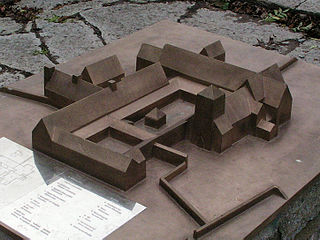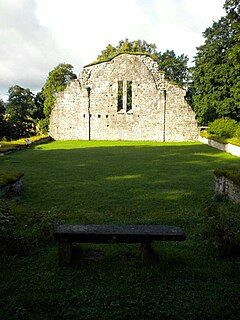Nicolaus Ragvaldi was a monk in the Bridgettine Abbey of Vadstena, and served twice as its confessor general. He is known for a few translations and other writings known among the preserved parts of the library of the Abbey.

Anna Rheinholdsdotter Leuhusen, was the Abbess of St. Clare's Priory in Stockholm. She became known for her involvement in the Swedish War of Liberation between Sweden and Denmark in the 1520s.
Little Agda and Olof the Silent, refers to a legend about a young couple in Sweden between the very first years of King Gustav Vasa (1523) and the last years of before the Lutheran Reformation (1527).

Vreta Abbey, in operation from the beginning of the 12th century to 1582, was the first nunnery in Sweden, initially Benedictine and later Cistercian, and one of the oldest in Scandinavia. It was located in the present-day municipality of Linköping in Östergötland.

St. Clare's Priory, Stockholm, was a Roman Catholic nunnery of the Poor Clares in Stockholm, Sweden that was active from 1289 to the Swedish Reformation in 1527.
Birgitta Botolfsdotter, or Botulfsdotter was a Swedish Roman Catholic nun, abbess of Vadstena Abbey during the ongoing Protestant Reformation.
Ingegerd Knutsdotter was a Swedish nun and noble, the first official abbess of the Bridgettine Abbey of Vadstena in 1385/88–1403.
Katarina Bengtsdotter Gylta, in Latin: Catharina Benedicta, was a Swedish nun of the Bridgettine Order, Abbess of Vadstena Abbey in 1553–1564 and 1565–1593. She was the second last abbess in Sweden and Vadstena Abbey after the reformation.
Ingrid Persdotter, was a Swedish nun at the convent of Saint Birgitta in Vadstena. She is famous for having written passionate Love Letters to a knight named Axel Nilsson in 1498.
Christina Hansadotter Brask, or Christin Hansadotter, was a Swedish writer and translator, and a member of the Bridgettine Order in Vadstena Abbey.
Christina Nilsdotter was a Swedish singer and song teacher. She was a member of the Bridgettine Order in Vadstena Abbey and well known as an artist for her ability and talent.
Gerdeka Hartlevsdotter, or Hartlefsdotter, also called Gerdica (1370-1438), was a Swedish Bridgettine nun. She was the abbess of Vadstena Abbey from 1403 until 1422.
Anna Paulsdotter, was a Swedish Bridgettine nun. She was the abbess of Vadstena Abbey from 1486 until 1496.

Riseberga Abbey, was a Cistercian nunnery in Sweden, in operation from circa 1180 until 1534. It was located near Fjugesta in Närke. It had the right to appoint the vicar of the Edsberg parish, which was under the jurisdiction of the abbey. The ruins of the buildings are preserved, and the Amphitheatre of the abbey are presently used as a Sylvan theater.
Skänninge Abbey, also known as St. Ingrid's Priory, St. Martin's Priory or, simply, as Skänninge Nunnery, was a Roman Catholic convent for females of the Dominican Order in Skänninge in Sweden, in operation from 1272 until 1544. It was founded by Saint Ingrid of Skänninge, and the center of her cult, and as such, it was often referred to as St. Ingrid's Priory. Located near the church dedicated to Martin of Tours, it was originally named St. Martin's Priory, though this name was rarely used in practice. The common name for it was Skänninge Abbey, but as there was also a convent for male members of the Dominican Order in Skänninge, it was often called Skänninge Nunnery to separate it from the male monastery.

Askeby Abbey, was a Cistercian nunnery in Sweden, in operation from the late 12th century until 1529. It was located in Askeby outside Linköping.
Marienbrunn Abbey also called Fons Mariae and Triumphus Marie was a double convent for women and men of the order of the Bridgettines, situated in Gdańsk between 1391 and 1833. It was the first convent of the order founded outside of Sweden, and the second convent of the order altogether.
Karin Johansdotter, was a Swedish Roman Catholic nun of the Bridgettine Order. She was the last nun in Sweden after the Swedish Reformation.












